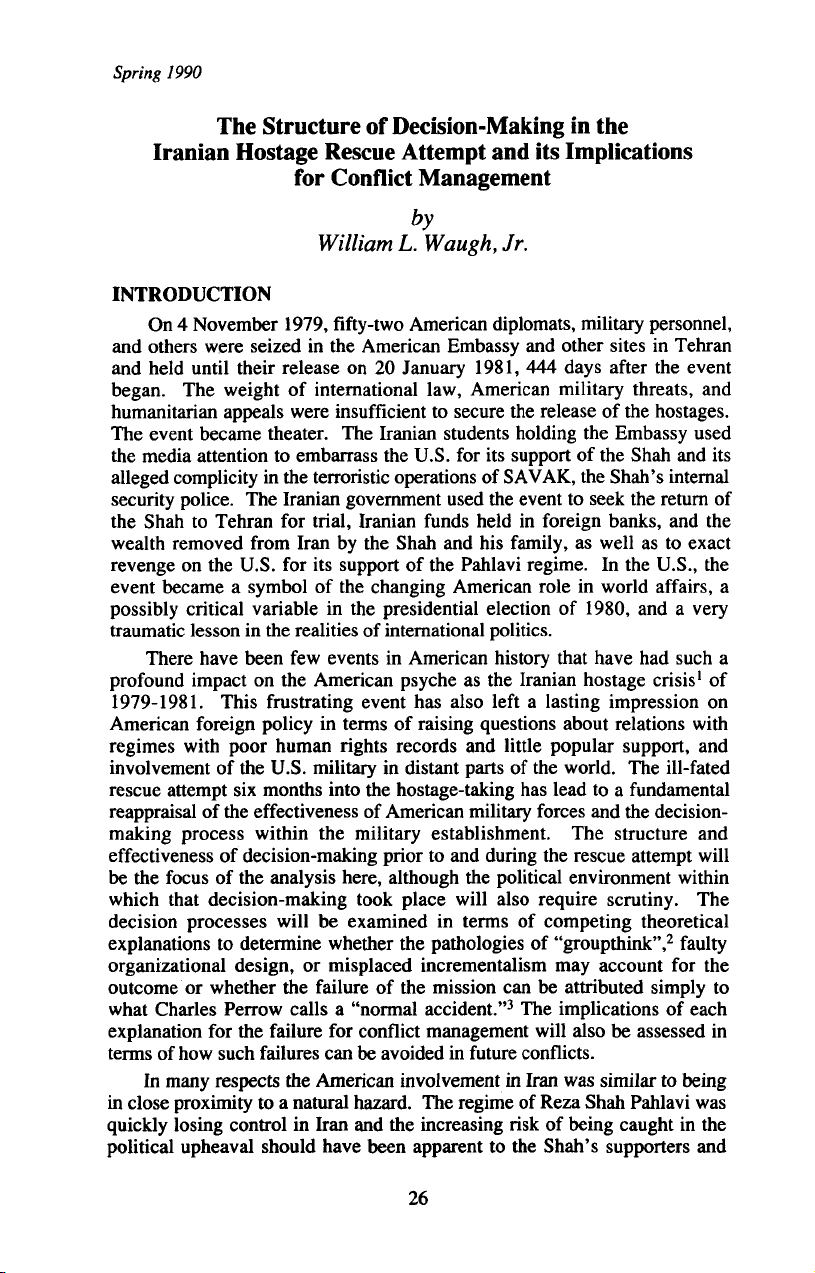











Study with the several resources on Docsity

Earn points by helping other students or get them with a premium plan


Prepare for your exams
Study with the several resources on Docsity

Earn points to download
Earn points by helping other students or get them with a premium plan
Community
Ask the community for help and clear up your study doubts
Discover the best universities in your country according to Docsity users
Free resources
Download our free guides on studying techniques, anxiety management strategies, and thesis advice from Docsity tutors
An analysis of the Iranian Hostage Crisis of 1979-1981, its impact on American foreign policy, and the implications for conflict management. the political context of the hostage-taking, the decision-making process within the U.S. government, and the failed rescue attempt. It highlights the intelligence failures, interagency competition, and the role of fear in the negotiations.
Typology: Study notes
1 / 15

This page cannot be seen from the preview
Don't miss anything!










Spring 1990
On 4 November 1979, fifty-two American diplomats, military personnel, and others were seized in the American Embassy and other sites in Tehran and held until their release on 20 January 1981, 444 days after the event began. The weight of international law, American military threats, and humanitarian appeals were insufficient to secure the release of the hostages. The event became theater. The Iranian students holding the Embassy used the media attention to embarrass the U.S. for its support of the Shah and its alleged complicity in the terroristic operations of SAVAK, the Shah's internal security police. The Iranian government used the event to seek the return of the Shah to Tehran for trial, Iranian funds held in foreign banks, and the wealth removed from Iran by the Shah and his family, as well as to exact revenge on the U.S. for its support of the Pahlavi regime. In the U.S., the event became a symbol of the changing American role in world affairs, a possibly critical variable in the presidential election of 1980, and a very traumatic lesson in the realities of international politics. There have been few events in American history that have had such a profound impact on the American psyche as the Iranian hostage crisis^1 of 1979-1981. This frustrating event has also left a lasting impression on American foreign policy in terms of raising questions about relations with regimes with poor human rights records and little popular support, and involvement of the U.S. military in distant parts of the world. The ill-fated rescue attempt six months into the hostage-taking has lead to a fundamental reappraisal of the effectiveness of American military forces and the decision- making process within the military establishment. The structure and effectiveness of decision-making prior to and during the rescue attempt will be the focus of the analysis here, although the political environment within which that decision-making took place will also require scrutiny. The decision processes will be examined in terms of competing theoretical explanations to determine whether the pathologies of "groupthink",^2 faulty organizational design, or misplaced incrementalism may account for the outcome or whether the failure of the mission can be attributed simply to what Charles Perrow calls a "normal accident."^3 The implications of each explanation for the failure for conflict management will also be assessed in terms of how such failures can be avoided in future conflicts.
In many respects the American involvement in Iran was similar to being in close proximity to a natural hazard. The regime of Reza Shah Pahlavi was quickly losing control in Iran and the increasing risk of being caught in the political upheaval should have been apparent to the Shah's supporters and
Conflict Quarterly
allies. Although the danger to American personnel and interests was mounting daily, the American intelligence community apparently did not provide an accurate assessment of the risk. While nonessential personnel were being removed from the Embassy, the hostage-taking was not anticipated fully enough to minimize the threat to personnel and to prevent the loss of sensitive diplomatic materials. In a larger sense, the U.S. failed to distance itself from the Shah's regime to minimize the political losses from a popular uprising.
The discussion that follows will focus on the nature of the Iranian hostage crisis and on both how it challenged the capacity of the American government to respond to threats beyond its jurisdiction, as exemplified by the failed rescue mission, and how such events can be avoided. The lessons of 1979-1981 have some currency today given the prolonged conflict over hostages taken in Beirut; the Reagan Administration's trading of weapons for hostages exposed during Congressional hearings in 1986-1988 and reexamined minutely during the subsequent criminal investigations of the principals; and the atmosphere of uncertainty in the Persian Gulf area following the death of Ayatollah Khomeini, and the withdrawal of Soviet troops from Afghanistan. Administratively, the crisis has had a positive effect in that it has precipitated an intensive examination of the organization of the Joint Chiefs of Staff (JCS) and the apparatus for advising the president on national security affairs. Reforms are still being implemented in those areas in response to the aborted rescue mission in 1980 and the evident excesses of National Security Council personnel later in the decade.
The seizure of the American Embassy in Tehran on 4 November 1979, concluded an era of American influence in Iran that began with CIA involvement in the overthrow of the Mossadegh regime by Mohammad Reza Shah Pahlavi in 1953. During the next two decades strong ties developed between the Shah and an influential group of American leaders, including President Richard Nixon and Secretary of State Henry Kissinger.
Those close personal ties and the importance of Iran to the U.S.'s strategic interests, as well as the tremendous wealth generated by the Iranian oil fields, resulted in a strong U.S. commitment to the Shah's regime and rapidly expanding military sales. Economic growth and increased Westernization of Iranian society created internal conflicts that eventually led to an "Islamic revolution" headed by the religious leadership. As supporters of the Shah, Americans were principal targets of the violent revolution.
By late 1978 it was apparent that the Shah's hold on the Peacock Throne was tenuous, although U.S. intelligence agencies apparently underestimated the strength of popular opposition. The Shah met increasing anti-regime violence with tentative reform efforts. Whether the intent to establish democratic reforms was real or not, the regime eventually fell victim to its own cultural underpinnings.
Conflict Quarterly
Americans were captured in or near the Embassy, at the Iranian foreign ministry, and at the Iran-America Society offices. Despite U.S. threats, the Iranian government appeared unwilling or unable to end the crisis. For the next 444 days, the U.S., Iran, and a variety of other actors exchanged threats, negotiated, and renegotiated the terms for the release of the hostages and the return of the Shah and Iranian assets.
Because of the chaotic state of affairs in Iran during the hostage-taking, it was not always clear whether the revolutionary government was in control of events. The hostages became pawns in the internal struggle for influence. The period was also one of intense frustration in the U.S. as negotiations failed repeatedly. The 1980 presidential campaign was underway and the inability of the Carter Administration to resolve the problem became a major issue.
The rescue attempt occurred in late April 1980, several weeks after President Carter had severed diplomatic relations with Iran and imposed a trade embargo, and after American allies were beginning to cooperate with that action. On the 25th, the Administration announced the cancellation of a rescue mission due to equipment failure. It was revealed that eight American military personnel had been killed in an accident in the Iranian desert when a helicopter collided with a transport plane. The bodies of the American crewmen were displayed on Iranian television before being returned to the U.S.
The immense frustration of the American public perhaps was best illustrated by the large number who expressed some satisfaction that "something had been done" even if it had failed. The nations that had joined the U.S. trade embargo of Iran were not apprised of the rescue mission and generally expressed surprise and irritation that the mission was attempted while they were led to believe that the U.S. was committed to nonmilitary options. After the rescue attempt, the hostages were moved to locations outside of the American Embassy to discourage further attempts. U.S. Secretary of State Cyrus Vance who had opposed the mission resigned and Senator Edmund Muskie was named as his successor. The remainder of the year was filled with negotiations (principally through Algeria), political machinations in Iran as moderate and radical elements sought advantage (complicated by the beginning of the Iran-Iraq war), and intensifying frustration in the U.S. as the deadlock continued. Resolution of the dilemma appeared imminent several times during the fall, but it finally became clear that the crisis would not end before the November election. Deputy Undersecretary of State Warren Christopher concluded final negotiations in Algeria in January and the hostages were flown to Weisbaden, West Germany, via Algiers, on President Reagan's inaugural day.
Spring J 990
The events of November 1979 and the following fourteen months presented a number of difficulties for the U.S. government. The seizure of the embassy was a gross violation of international law and the U.S. had the support of the United Nations, the International Court of Justice, and other international agencies. The Carter Administration had very little leverage within the Iranian government. The more radical religious elements effectively inhibited negotiations with moderate leaders. Indeed, the political situation was such that the moderate Iranian leaders could not appear overly sensitive to the U.S. position without jeopardizing their own standing. The Revolutionary Council viewed the hostage-taking as an opportunity to expand its own influence and to embarrass the U.S. by attracting international attention to American complicity in the Shah's oppressive regime. In administrative terms, the affair proved a challenge to the crisis decision-making apparatus in the U.S. The State Department activated its operation center with an Iran Working Group providing coordination of the multi-agency response and managing the operations in general, as well as maintaining contact with the families of the hostages. Secretary of State Vance and Deputy Secretary Christopher, along with the Undersecretary for Political Affairs, provided policy guidance, with Assistant Secretary Harold Saunders acting as liaison between the two groups.^8 The Special Coordinating Committee of the National Security Council, chaired by National Security Advisor Zbigniew Brzezinski, handled the development of policy within the White House. At least initially, information was collected directly from Iran via telephone by simply calling public officials and even persons within the U.S. embassy.^9 The Chairman of the Joint Chiefs of Staff represented the Department of Defense in the National Security Council. The Joint Chiefs presented military options to the SCC two days after the hostage crisis began. These options included a rescue attempt and retaliatory strikes and President Carter asked the JCS to develop both plans. A military blockade and other options were also considered seriously, and the Navy moved two naval battle groups into the Arabian Sea outside of the Persian Gulf.^10 However, because there were several major problems with choosing military options, including the likelihood that reprisals would be directed against other Americans in Iran as well as against the hostages themselves, the use of military force was generally considered as a last resort — if the hostages were harmed or put on trial. Congress was generally involved in the negotiation process and in the development of military plans. Restrictions on executive freedom of action implemented after the resignation of President Nixon, such as the War Powers Act of 1973, the National Emergency Act of 1976, and the International Emergency Economic Powers Act of 1977, required consultation with Congress before actions could be taken."
Spring 1990
Air Force Major General Philip G. Gast was brought in first as a "special Consultant" in charge of aircraft pilot training, and twelve days before the operation was formally designated as the deputy task force commander — despite his outranking Vaught. Similarly, U.S. Marine Colonel Charles H. Pitman was an unofficial participant in the operation, but became the de facto commander of helicopter training — most of the pilots were Marines — and flew one of the helicopters involved in the operation. Marine Lieutenant Colonel Edward R. Seiffert was ostensibly assigned as the helicopter flight leader, although that status was unclear with Col. Pitman involved in the operation. Again, the chain of command lacked coherence.^15 Finally, Army Colonel Charlie A. Beckwith was commander of the Delta Force team that was to enter die Embassy and free the hostages. Air Force Colonel James Kyle was in charge of the C-130 transport aircraft and the "Desert One" base fifty miles from Tehran, where the aircraft were to drop off the Army's Delta Force team and supporting Ranger troops and wait for their return with the hostages.^16 Troops were moved into the area through Egypt and Oman, without apprising those nations of the mission. Vaught established his base at Qena, Egypt, to oversee the operation. He maintained contact with the JCS and the President, through the Secretary of Defense, Harold Brown.^17 On 24 April the rescue force departed the U.S.S. Nimitz. It was expected that six helicopters were the minimum needed to accomplish the mission. Eight left for Tehran. One was abandoned in the desert when a warning light indicated mechanical problems. Another, flown by Col. Pitman, developed problems and returned to the Nimitz. An unanticipated dust cloud ("haboob") delayed arrival at the first desert landing site by fifty to eighty-five minutes, throwing off the timing of the mission. A third helicopter developed hydraulic problems, leaving only five. The mission was aborted but, as the aircraft prepared to leave the air strip, one of the helicopters crashed into the refueling plane. Eight crewmen died and five were injured.^18 In the confusion and haste of the departure, the bodies were left at the crash site along with classified materials on board the abandoned helicopters. The public display of the bodies and materials by Iranian authorities later intensified American frustration with the hostage-taking.
The failed rescue has been examined from a variety of perspectives since
Conflict Quarterly
Conflict Quarterly
that, to some extent, there was a search for alternative actions, but that political factors had a significant impact on the range of choices. The identification of the problem and the determination of the imperative to act were characterized by "analogizing",^28 essentially interpreting the situation to be the same or very nearly the same as another more familiar situation. Faulty analogizing, it is suggested, can affect decision-making when the unique characteristics of a situation or event are overlooked because decision- makers choose to respond in the same way as they did to a prior situation. In this case, the principals in the decision to attempt the Entebbe rescue tended to relate the event to another recent dramatic event^29 with little real attention given to the fit. The search for alternatives was then curtailed when an option was arrived at that matched the predisposition of the group.^30 In short, the Israeli leadership was predisposed toward a military operation and massaged the rescue plans until the probability of success reached an acceptable level, according to Moaz. Some adjustments were made in the plan as circumstances changed, but only minor ones. The personalities involved, particularly Defense Minister Peres and Prime Minister Rabin, also contributed to the decision to attempt the rescue, despite Rabin's initial preference for negotiation.
The decision to attempt the rescue in Tehran was arrived at in a very similar manner. There was tremendous political pressure to act and there were few options available except for diplomatic and military actions. The effects of economic sanctions were questionable. Because of the hostages and other Americans in Iran, other, broader military actions were not viable options. The "analogizing" may well have been in terms of interpreting the U.S. situation in Iran as comparable to the Israeli situation in Entebbe, although the situations were only superficially similar. American policy on terrorism, as well as broader Middle Eastern policies, had tended to be similar to the Israelis', despite the dissimilarities in the types of violence they were designed to address and the level of threat that the violence presented to each society.^31 The successful West German rescue of hostages at the Mogadishu airport in Somalia might also have contributed to the tendency to "analogize," despite the more recent failed attempts by Egypt to use military forces to rescue hostages. Concerns have been expressed about the inappropriate application of the Israeli rescue model in subsequent hostage-takings.^32
This analysis certainly does not exhaust the possible explanations, but it does explicate some of the more plausible ones.
Realistically, the Carter Administration had very few options. The imposition of economic sanctions was impeded by the sheer difficulty of severing economic ties and enlisting the support of allies in such efforts. The military options were constrained by the realization that other Americans, including journalists, were in Iran and could be taken hostage if those in the Embassy were rescued, violence against Iranians civilians might precipitate
Spring 1990
violence elsewhere, and a strong military response might force Iran into an alliance with the Soviet Union. Recourse through international law was not promising because Iran simply refused to accept United Nations and International Court of Justice condemnations of the hostage-taking. The lack of a unified military force to deal with hostage situations outside of U.S. borders turned out to be a significant problem, although there is no assurance that the rescue would have been effective under the best of circumstances.^33 Since the hostage crisis such a unit has been created by the JCS, along with policy review mechanisms to oversee future rescue efforts.^34 The fact of the matter is that diplomatic personnel and facilities are vulnerable to attacks as subsequent assaults on U.S. facilities in Lebanon and elsewhere have demonstrated, despite increased embassy security worldwide and international conventions against such actions. Many analysts and commentators indicate that the decisive factor in the negotiations was the fear by the Iranian government that newly elected President Reagan would use military force without regard for the costs to the U.S. in lives and strategic considerations. Certainly the rhetoric of the 1980 campaign would suggest such an inclination. It must also be noted that the election campaign intensified the pressure on President Carter to act decisively, both to improve his own prospects for reelection and to enhance the prospects for other Democratic candidates. The President's "rose garden" strategy, in which he declined to campaign actively for reelection while the hostages were held, was intended to impress the public with Carter's attention to the business of the presidency, including the hostage crisis. The strategy, in fact, may have attracted greater attention to the hostage crisis and increased the President's political investment in its resolution. When the rescue failed, Carter — hoping to minimize the political damage — reviewed tapes and followed the example provided by President John Kennedy's explanation of the Bay of Pigs fiasco to the American people in 1961. Notwithstanding those concerns, many commentators and several of the hostages commended the President for attempting the rescue.^35 The pathology of "groupthink" both among the President's advisors — which was complicated by the conflict between his two principal foreign policy advisors, Vance and Brzezinski — and among the rescue team members provides a compelling explanation of the decision to attempt a rescue and perhaps for its failure. It is uncertain that the rescue would have been a success under any but the most 'ideal' — and unlikely — circumstances. Organizational flaws and the tendency toward misplaced incrementalism and faulty "analogizing" also explain many of the problems that arose during the mission. The notion that the failure was due to a "normal accident" raises the question of whether the mission could have succeeded if the requisite number of helicopters had been available to take the rescue team into Tehran. This is the question that is the most problemmatic. Was the failure simply one of those inexplicable and unpredictable accidents that occur in complex systems, as the Holloway Report concludes? Given the minimal redundancy built into the system itself, that is not the best answer.
Spring 1990
predicted significant casualties among the hostages. That choice may have been made with complete awareness of the implications, although there is little to suggest that this was the case in the White House. In large measure, the incrementalism reflected in the limited range of options considered and the design of the organization set up to implement the operation are a reflection of the agencies involved in the decision-making.^37 A decision- making process that includes officials and experts from outside of the National Security Council and the defense and intelligence communities would likely broaden the range of options considered, assure a wider assessment of the implications of actions, and reaffirm the value of the lives threatened. What has been suggested is that the U.S. develop a permanent mechanism for responding to crises outside of U.S. boundaries and that this group include agencies outside of the national security establishment to minimize the tendencies toward "groupthink" and incrementalism. The next task will be to avoid faulty "analogizing", i.e. assuming that future incidents are the same as the Iran hostage crisis. With luck, a "normal accident" will not prove fatal to the resulting operations. Finally, the tendency to micromanage — to attempt to direct or, at minimum, second-guess operations occurring thousands of miles away — will have to be resisted by political leaders and Pentagon commanders. While communication technologies permit leaders in Washington to participate in operational decision-making all over the world, the technologies do not yet give them sufficent information to justify overruling onsite commanders. Contingency planning should guide operational decision-making.
Endnotes
Conflict Quarterly
5. Sick, All Fall Down, pp. 34-77, 139; and, Sick, "Military Options and Constraints," in American Hostages in Iran, **pp. 144-72.